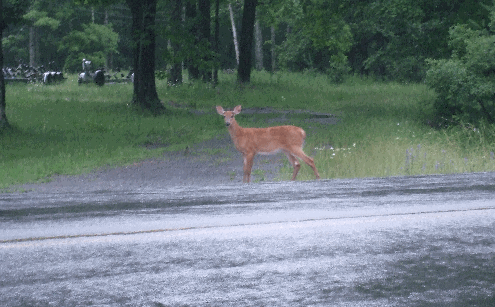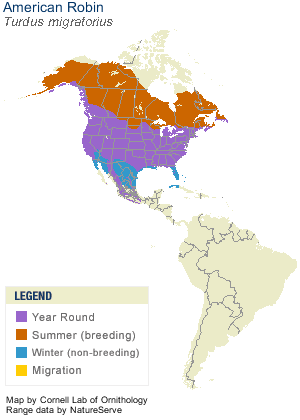A Snake on the Step

I stepped out the front door this week and ran into this little guy on the front step. We were both surprised to be looking at each other, but I got his picture! Don’t worry though. If you come to our house, he has been relocated to a spot where he doesn’t have to look at me or any tourists who might scare him!
To learn more about garter snakes look here.
Deer on Mountain

A True Loon
…..with a little loon behind.

‘Why Didn’t the Kitty Play Nice?’
While this story happened on the west coast of Canada, this mother deserves some type of big award:
Mother fought off cougar to save toddler from attack
However it got me thinking about the possibility of cougars/mountain lions living in the Adirondacks. The Adirondack Almanack did a good story on this some time ago.
Two Ducks

I came across these two mallard ducks sitting on a dock and I creeped up as close as I could to get a good picture.
I was thinking about ducks because yesterday was the anniversary of the creation of Disney’s Donald Duck.
A Tree Grows in Huletts
Birch tree at the end of the 5th hole.
Bits of Everything
Lake Homes Sales Take Hit
Sales are slow this year on Lake George. Read the Post Star article here.
Please Don’t Feed the Bears
The Adirondack Alamanack had a good story on what happens when bears get fed.
Whitehall Police to be Outsourced
I wonder how the Washington County Sheriff will handle sightings of Bigfoot?
Heron Finally
I’ve been trying to get a decent picture of this heron for some time. This morning I got close and finally got some. These were the best two.

Bits of Everything
Whitehall School Budget Set For Vote
The Whitehall Times has a good piece on the school budget up for vote next week. I’ll have more analysis over the weekend.
Mammals, Mammals, Everywhere

The Adirondack Almanack has a really interesting piece on the number of mammals in the Adirondacks. It has some great statistics about the moose and bear populations.
NY Post Picks Lake George
Lake George is ranked # 2 in a NY Post survey of inexpensive destinations close to NY City. Then again, you know that!
Bits of Everything

The Attack of the Killer Tomatoes: Take Two
Ever heard that Japanese knotweed or garlic mustard threaten the Adirondacks? Well they do. Read the Adirondack Alamanacks’ article on how the Adirondack Park Invasive Plant Program (APIPP) was one of 26 projects across New York State to receive the U.S. Environmental Protection Agency’s highest honor: the Environmental Quality Award.
This is Wrong: NY State as the Godfather
The State of NY has gone off the deep end with this move. Expect more businesses to leave NY over this one.
Washington County Sales Tax Down
This is not good news for next years Washington County Budget.
Bits of Everything
The Robin
Here is a picture of a robin that was spotted in Huletts this week.
 “The quintessential early bird, American Robins are common sights on lawns across North America, where you often see them tugging earthworms out of the ground. Robins are popular birds for their warm orange breast, cheery song, and early appearance at the end of winter. Robins are the largest North American thrushes, and their profile offers a good chance to learn the basic shape of most thrushes. Robins make a good reference point for comparing the size and shape of other birds, too. They bound across lawns or stand erect, beak tilted upward, to survey their environs. When alighting they habitually flick their tails downward several times.”
“The quintessential early bird, American Robins are common sights on lawns across North America, where you often see them tugging earthworms out of the ground. Robins are popular birds for their warm orange breast, cheery song, and early appearance at the end of winter. Robins are the largest North American thrushes, and their profile offers a good chance to learn the basic shape of most thrushes. Robins make a good reference point for comparing the size and shape of other birds, too. They bound across lawns or stand erect, beak tilted upward, to survey their environs. When alighting they habitually flick their tails downward several times.”


